The Bain Online Test seems to be all the rage recently. Considering the spike of interest and questions I receive from my readers, I decided to write this comprehensive guide.
As it turns out, Bain Online Test is not that different from the popular aptitude tests, or the more specialized tests used at McKinsey or BCG. In this article I’ll explain the most common formats of the Bain Online Test, give you a few samples, and tell you how to prepare for each of them.
Bain Online Test overview & format
What is Bain Online Test?
Bain Online Test or Bain Online Assessment is a collection of pre-interview screening tests used by Bain & Company. It assesses the candidate on verbal, numerical and logical reasoning, often using 25-30 multiple choice questions done in 30-50 minutes. No business background is required. The tests are computer-based, although some offices require physical attendance at proctored sites.

In Bain’s recruitment process, the Online Test stands between resume screening and interviews or accompanies resume screening. The purpose is to filter out candidates without the necessary skills or traits even before interviews – minimizing lost consultant-hours while maximizing recruitment scope and selection effectiveness.
Bain Online Test assesses the candidate on skills and traits necessary for consulting work – no prior experience is needed. However, many tests are put in business context, and under tight time limits, so advance practice and some background knowledge is essential.
Unlike the more well-known McKinsey PST, “Bain Online Test” is not a uniform test applied in all offices across the world. In fact, even whether any test is implemented at all depends on each Bain office. The test designer, format, and specific question types all vary from place to place. Additionally, very little official information is disclosed, making it difficult to prepare with precision as with the PST.
Fortunately, most tests at different Bain offices are similar in structure and underlying principles. That means you can indeed prepare for those tests with the same general approach.
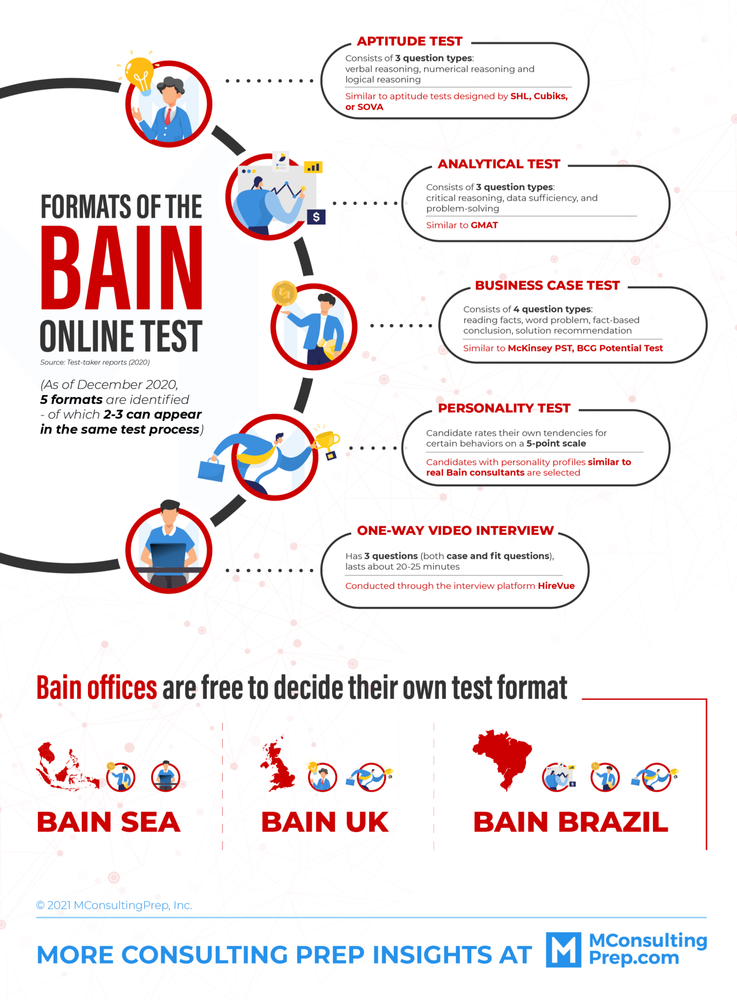
Bain Online Test formats
Currently, the Bain Online Test may include the following components:
- Aptitude Test: tests the cognitive abilities of the candidate – namely logical, numerical, and verbal reasoning – similar to common aptitude tests available online.
- Personality Test: requires the candidate to rate “most likely” and “least likely” on given traits to decide their “fit” with Bain culture and consulting job nature.
- Analytical Test: this format is based on the GMAT, with questions on critical reasoning, data sufficiency, and problem-solving.
- Business Case Test: this format presents a full business case along with multiple-choice questions – similar to the McKinsey PST and BCG Potential Test.
- One-Way Video Interview: this is not so much a “test”, but in certain offices, it does appear during the testing round, so make sure to prepare yourself; this interview includes both behavioral and case questions.
In this article, we’ll first address the two common online formats – collectively called “psychometric test”, before moving on to the less-popular case tests, GMAT-based tests and video interviews.
Bain Online Test passing score / cut-off rate
Bain Online Test passing score / cut-off rate is about about 70-75% according to test-takers’ report, although Bain does not explicitly state an official figure. This score is similar to other consulting screening tests such as McKinsey PST or BCG Potential Test; and since the difficulty of Bain Online Test is not markedly different, one should expect an acceptance rate of around 30-35%.
Bain psychometric test - Aptitude Test
Aptitude test is currently reported to be the most common format of the Bain Online Test – so make sure to prepare extensively. They are also used in many other firms as well (not just Bain or consultancies), so good practice will enhance your chances in all kinds of jobs.
Certain Bain offices, such as Bain UK, utilize aptitude tests designed by SHL, Cubiks, or SOVA, consisting of 3 question types: verbal reasoning, numerical reasoning, and logical reasoning. Currently, Bain tests from SOVA appear to be the most common among Bain offices.
Question type 1: Verbal reasoning
Verbal reasoning questions provide the candidate with passages of text, followed by multiple-choice questions, mainly in the True/False/Cannot Say format. They supposedly test the candidate’s ability to comprehend complex written language.
These questions are similar to Reading Facts and Fact-Based Conclusion Questions from the PST.
Here are a few examples of verbal reasoning questions from SHL:
EXERCISE – VERBAL REASONING
Passage
Many organizations find it beneficial to employ students over the summer. Permanent staff often wish to take their own holidays over this period. Furthermore, it is not uncommon for companies to experience peak workloads in the summer and so require extra staff. Summer employment also attracts students who may return as well-qualified recruits to an organization when they have completed their education. Ensuring that the students learn as much as possible about the organization encourages interest in working on a permanent basis. Organizations pay students on a fixed rate without the usual entitlement to paid holidays or bonus schemes.
Statement 1: It is possible that permanent staff who are on holiday can have their work carried out by students.
A. True
B. False
C. Cannot Say
Answer
This statement is true (Option A) as the passage states: “Many organizations find it beneficial to employ students over the summer. Permanent staff often wish to take their own holidays over this period.”
Statement 2: Students in summer employment are given the same paid holiday benefit as permanent staff.
A. True
B. False
C. Cannot Say
Answer
This statement is false (Option B) as the passage states: “Organisations pay students on a fixed rate without the usual entitlement to paid holidays or sick leave.”
Statement 3: Students are subject to the organization’s standard disciplinary and grievance procedures.
A. True
B. False
C. Cannot Say
Answer
We cannot say whether this statement is true or false (Option C) as the passage does not make reference to the discipline or grievance procedures for students.
Statement 4: Some companies have more work to do in the summer when students are available for vacation work.
A. True
B. False
C. Cannot Say
Answer
This statement is true (Option A) as the passage states: “Furthermore, it is not uncommon for companies to experience peak workloads in the summer…”.
Question type 2: Numerical reasoning
Numerical reasoning questions present facts and figures in statistical tables, which the candidate must use to answer multiple-choice questions. In each question, there is only one correct answer. These questions are supposed to test the candidate’s ability to work with quantitative data.
These questions are similar to Word Problems from the PST:
Here are a few examples of numerical questions from SHL:
EXERCISE – NUMERICAL REASONING

Question 1: Which newspaper was read by a higher % of females than males in Year 3?
A. The Tribune
B. The Herald
C. Daily News
D. Daily Echo
E. The Daily Chronicle
Answer: D
To answer this question, you need to compare the data in the column ‘Percentage of adults reading each paper in Year 3’ from the Newspaper Readership table. The only newspaper with more female than male readers is the Daily Echo. Therefore, the answer is D.
Question 2: What was the combined readership of the Daily Chronicle, the Daily Echo, and The Tribune in Year 1?
A. 10.6
B. 8.4
C. 9.5
D. 12.2
E. 7.8
Answer: C
To answer this question, you need to look at the data in the “Year 1 Readership (millions)” column from the Newspaper Readership Table. To calculate the combined readership for the three newspapers mentioned, add the readership numbers. Therefore, the solution to this answer would be calculated as follows: The Daily Chronicle readership = 3.6 million; Daily Echo readership = 4.8 million; The Tribune readership = 1.1 million => TOTAL READERSHIP = 9.5 million.
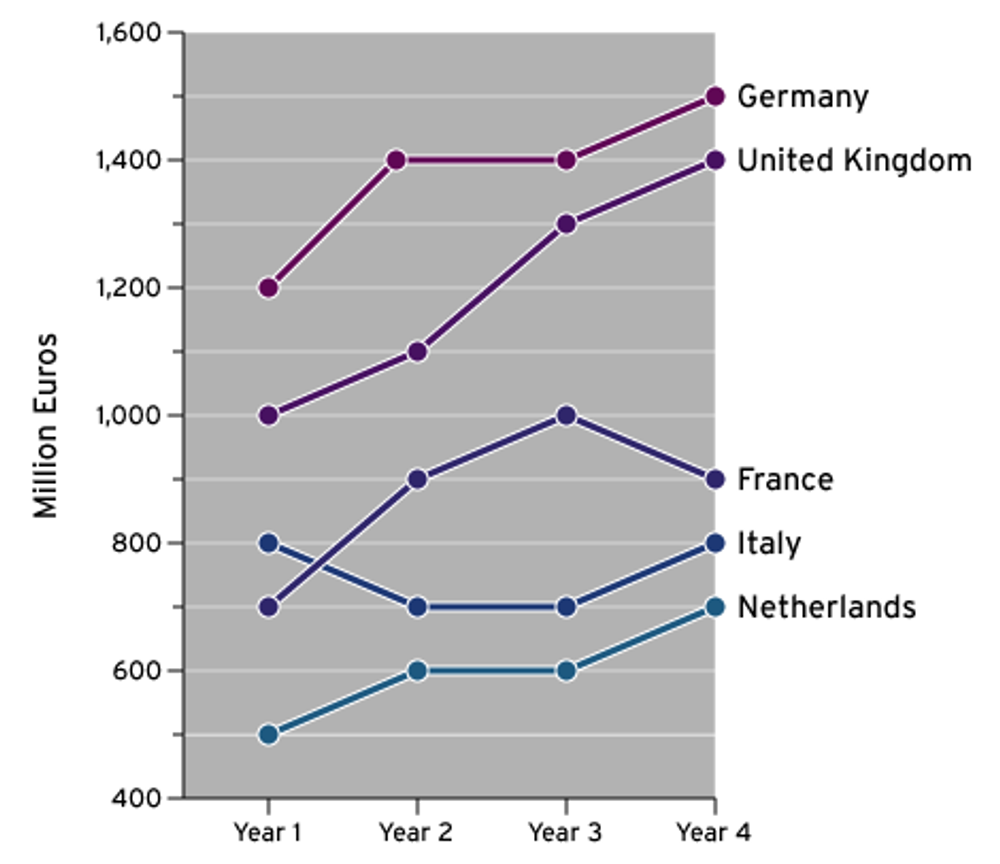
Question 3: In Year 3, how much more than Italy did Germany spend on computer imports?
A. 650 million
B. 700 million
C. 750 million
D. 800 million
E. 850 million
Answer: B
To answer this question, you need to look at the figures from Germany and Italy for Year 3 in the ‘Amount Spent on Computer Imports’ graph. Germany spent 1,400 million Euros and Italy spent 700 million Euros. To work out how much more Germany spent than Italy, simply calculate the difference (1,400 million – 700 million), which leaves 700 million euros. Therefore, the answer is B.
Question 4: If the amount spent on computer imports into the United Kingdom in Year 5 was 20% lower than in Year 4, what was spent in Year 5?
A. 1,080 million
B. 1,120 million
C. 1,160 million
D. 1,220 million
E. 1,300 million
Answer: B
To answer this question, you need to look at the figures from the UK in Year 4 from the ‘Amount Spent on Computer Imports’ graph. From here, we can see that 1,400 million euros was spent in Year 4. To calculate the amount spent on computer imports in Year 5, we need to calculate 20% of 1,400 million: 1,400 (million) x 0.20 = 280 million (this is 20% of 1,400 million) 1,400 million – 280 million = 1,120 million. Therefore, the answer is B.
Question type 3: Logical reasoning
Logical reasoning questions are further divided into three types: inductive, deductive, and abductive.
The first type – inductive reasoning – is currently popular at Bain offices – but you should spend some time to prepare for the other types as well.
INDUCTIVE REASONING
Inductive reasoning is about using a specific case to infer general rules.
Inductive reasoning questions – also known as “abstract reasoning questions” – are the most common logical reasoning questions in recruitment processes. In these questions, the candidate is often required to complete a logical sequence (of shapes, numbers, or texts); the result reflects the ability of the candidate to handle abstract concepts and unfamiliar information – essential in problem-solving.
Here is an inductive reasoning question from SHL:
EXERCISE – INDUCTIVE REASONING
Complete the following sequences:
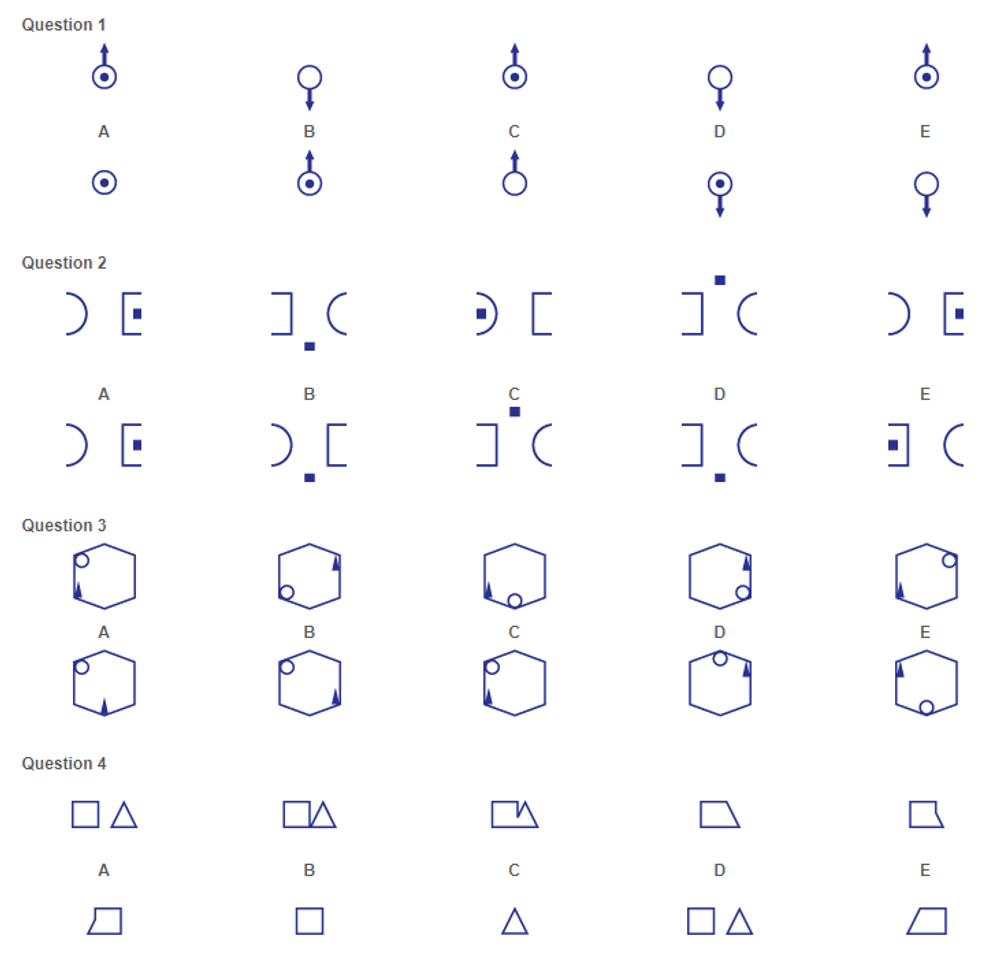
Answer - Question 1: E
In this example, there are two rules to follow. The first is that the centre of the circle follows the pattern that alternate circles have a dot in the centre. Following this rule, the next diagram in the sequence does not have a dot in the centre. Therefore, the correct answer must be C or E. The second rule is that the arrows change the direction that they point from up to down to back up again. Following this, the next diagram in the sequence must contain an arrow that points down. Therefore, the correct answer is E.
Answer - Question 2: D
In this example, there are two rules to follow. The first is that the semi-circle and semi-rectangle swap positions. Following this rule, the next diagram in this sequence will contain a semi-rectangle on the left side of the pattern and a semi-circle on the right side of the pattern. Therefore, the correct answer is C, D or E. The second rule is that small black square rotates clockwise. Following this pattern, the next diagram will contain a small back square at the bottom of the box. Therefore, the correct answer is D.
Answer - Question 3: D
In this example, there are two rules to follow. The first is that the circle rotates around the inside of the hexagon in an anti-clockwise direction. Following this rule, the next diagram will have a circle in the top corner of the hexagon. Therefore, the answer must be D. This can be confirmed by following the second rule that the black triangle alternates position from the bottom left of the hexagon to the top right and back to the bottom left again. Following this pattern, the next diagram must contain a black triangle in the top right corner of the hexagon. This confirms that the answer is D.
Answer - Question 4: B
In this example, there is one rule to follow. This is because the square and triangle slowly move towards the centre and finally merge. The next diagram must contain the square and triangle fully merged and therefore, the answer is B.
DEDUCTIVE REASONING
Deductive reasoning is the opposite of inductive – it’s about applying general rules or known facts to a specific case.
Deductive reasoning questions are less common than inductive questions. They often present the candidate with a set of facts, which the candidate must use to decide whether a certain statement is true/not true, or choose a “true/not true” statement from multiple options.
Here is an example deductive reasoning question from SHL:
EXERCISE – DEDUCTIVE REASONING
Nicole and all of her co-workers wear blue uniforms.
Andrew works with Nicole.
Olivia does not wear a blue uniform.
Everyone who wears a blue uniform also wears a white shirt.
Which statement must be true?
A. Olivia wears a white shirt.
B. Olivia does not work with Nicole.
C. Some of Nicole’s co-workers do not wear white shirts.
D. Olivia is a co-worker of Nicole.
E. Nicole does not wear a white shirt.
Answer: B
The question asks us to find the “must be true” statement ⇒ The correct answer must be the statement that is always TRUE based on the given premises.
Option A: Olivia wears a white shirt.
Since “Olivia does not wear a blue uniform” and “Everyone who wears a blue uniform also wears a white shirt”, we cannot be sure whether Olivia wears a white shirt. ⇒ We cannot say option A.
Option B: Olivia does not work with Nicole.
“Nicole and all of her co-workers wear blue uniforms”, but “Olivia does not wear a blue uniform” ⇒ Olivia is not Nicole’s co-worker. ⇒ Option B is true.
Option C: Some of Nicole’s co-workers do not wear white shirts.
As mentioned in the 1st premise, all of Nicole’s co-workers wear blue uniforms and “Everyone who wears a blue uniform also wears a white shirt” ⇒ Option C cannot be true.
Option D: Olivia is a co-worker of Nicole.
All of Nicole’s co-workers wear blue uniforms, but Olivia does not wear a blue uniform. ⇒ Option D is eliminated.
Option E: Nicole does not wear a white shirt.
Nicole wears a blue uniform, and “Everyone who wears a blue uniform also wears a white shirt”. Thus, Nicole also wears a white shirt. ⇒ Option E cannot be true.
Therefore, the correct answer is B.
ABDUCTIVE REASONING
Abductive reasoning is the most difficult among these three types, where the candidate must piece together a few facts to reach the most likely conclusion. Abductive reasoning questions rarely appear in recruitment processes, but candidates should at least familiarize themselves with this kind of reasoning to avoid unpleasant surprises.
Here is an example of abductive reasoning:
- When it rains, the trees get wet.
- The trees are wet.
- Therefore, it probably rained.
Bain psychometric test – Personality test
What does it look like?
Many offices of Bain utilize a personality test to assess the “fit” part of the candidate even before interviews. The exact details of the test remain obscure; however, Bain certainly uses a common format for the personality test, where you rate yourself on behavioral tendencies.
Candidates applying to Bain London office have reported a test based on SOVA’s personality test, so here are five example personality questions from SOVA:

How am I assessed?
The SOVA test assesses the following dimensions or traits. Bain’s personality test is likely to be similar – at least that’s what we know for Bain UK.
- Managing Complexity measures your ability to comprehend and solve complex problems
- Engaging with Others measures your leadership, persuasion, confidence, assertiveness, and openness
- Resilience measures your ability to handle stress and pressure
- Learning measures your willingness and ability to learn, as well as flexibility
- Decision-Making measures your strength of opinion and strategic approach
- Innovation measures your creativity and adaptability
- Self-drive / Motivation measures your willingness to spend extra efforts to achieve goals
There’s no hard “passing score” for each trait. These tests use the results to build your personality profile, and if it appears similar to Bain consultants, you will pass.
What should I keep in mind?
Relax and be yourself in these personality tests.
Don’t even think about faking your personality to get in. Here’s why:
- They can spot people who deliberately choose favorable traits – most of the time, the personality profile of those people look unnatural, with many conflicting traits here and there. Additionally, many test systems have trackers to rule them out even during testing.
- If you can cheat your way in, most likely you’ll fail the fit interview. It’s not too hard to trick a machine, but not senior consultants with many years of experience.
Note: Situational Judgment Test
Situational Judgment Tests or SJTs are becoming increasingly common as a substitute for separate aptitude and personality tests.
These tests put the candidate in common workplace situations and ask the candidate to deliver solutions. They are dual-purpose tests, subtly measuring both cognitive abilities and personality traits at the same time, while also being much more relevant to the workplace.
While I have not received any reports about Bain using SJTs, it remains a possibility. Should you come across any information about SJTs at Bain offices, or go through those tests yourself, feel free to comment at the end of this article.
Bain Online Test – Business case test
This format is quite similar to McKinsey PST and BCG Potential Test; the test is reported as either paper-based and computer-based – although the 2016 “Tips for Candidates” handout of the Sao Paulo office makes no explicit statement. The Business Case Test is used in South America and South-East Asia.
The South American version gives 2 cases, 15 multiple-choice questions, and a time limit of 45 minutes. The South-East Asia version gives 3 cases, 25 questions, and 50 minutes to answer.
The test is chart-heavy, much like real consulting presentations. Each case is accompanied by 5-7 charts. You can get a glimpse in the screenshot below:
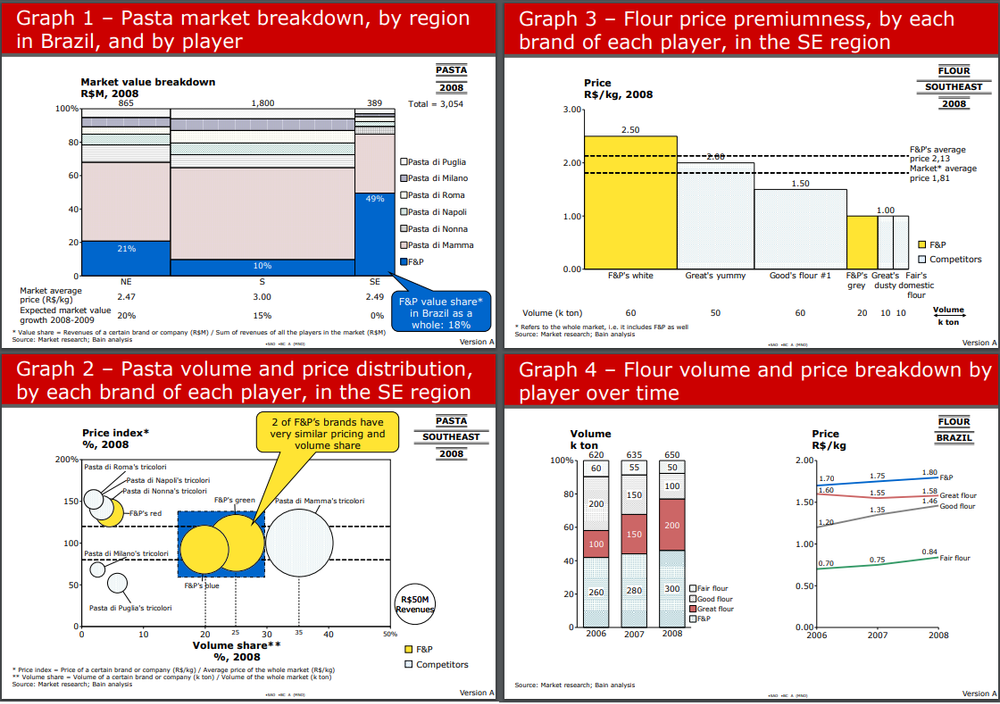
4 types of questions exist in business case test:
- Reading facts questions require the candidate to read and understand data (in this case, mostly charts and numbers), then choose a statement that accurately reflects the data.
- Math word problems require the candidate to perform complex calculations – don’t worry, they are no harder than school math, but you do need to be careful handling big numbers.
- Fact-based conclusion questions are similar to deductive reasoning – using facts to identify correct/incorrect statements in a given set.
- Solution-recommendation questions ask the candidate to choose an alternative from a given set, based on the data in the case.
3 out of the 4 questions above are present in the McKinsey PST as well. I have written an extensive guide on the PST, where I go in-depth into each and every question type – so if you want to absolutely nail those questions, check out this article: The ultimate guide to McKinsey PST
Bain Online Test – GMAT-based analytical test
Bain Analytical Test is similar to GMAT; they are either paper-based and computer-based, like the Business Case Test. It is used by Bain’s South American offices. Each test contains 15 questions, to be completed in 25 minutes.
There are 3 kinds of questions – all of them are multiple-choice questions from GMAT:
- Critical reasoning questions combine logical and verbal reasoning. These questions present an argument then ask the candidates to strengthen, weaken, evaluate, negate, etc. the given argument. There are 6 questions of this type in 2016.
- Data sufficiency questions combine logical and numerical reasoning. These questions present a question and two statements, then ask whether the given statements are sufficient to answer the question. There are 5 questions of this type in 2016.
- Problem-solving questions are the same as word problems in the McKinsey PST – which require constructing and solving math problems in worded contexts. The problems are usually quite simple compared to school math. There are 4 questions of this type in 2016.
Bain one-way video interview
This one is not exactly a “test”, but it often features in the testing round, so I feel like it would be better to put in here, instead of the other article on BCG & Bain Interviews.
Bain One-Way Video Interview is conducted through HireVue – a well-known video interview platform. The interview lasts 20-25 minutes in total, with 3 questions. For each question, you are allocated 5 minutes to prepare and 2 minutes to deliver the answer. You have only one attempt at answering each question.
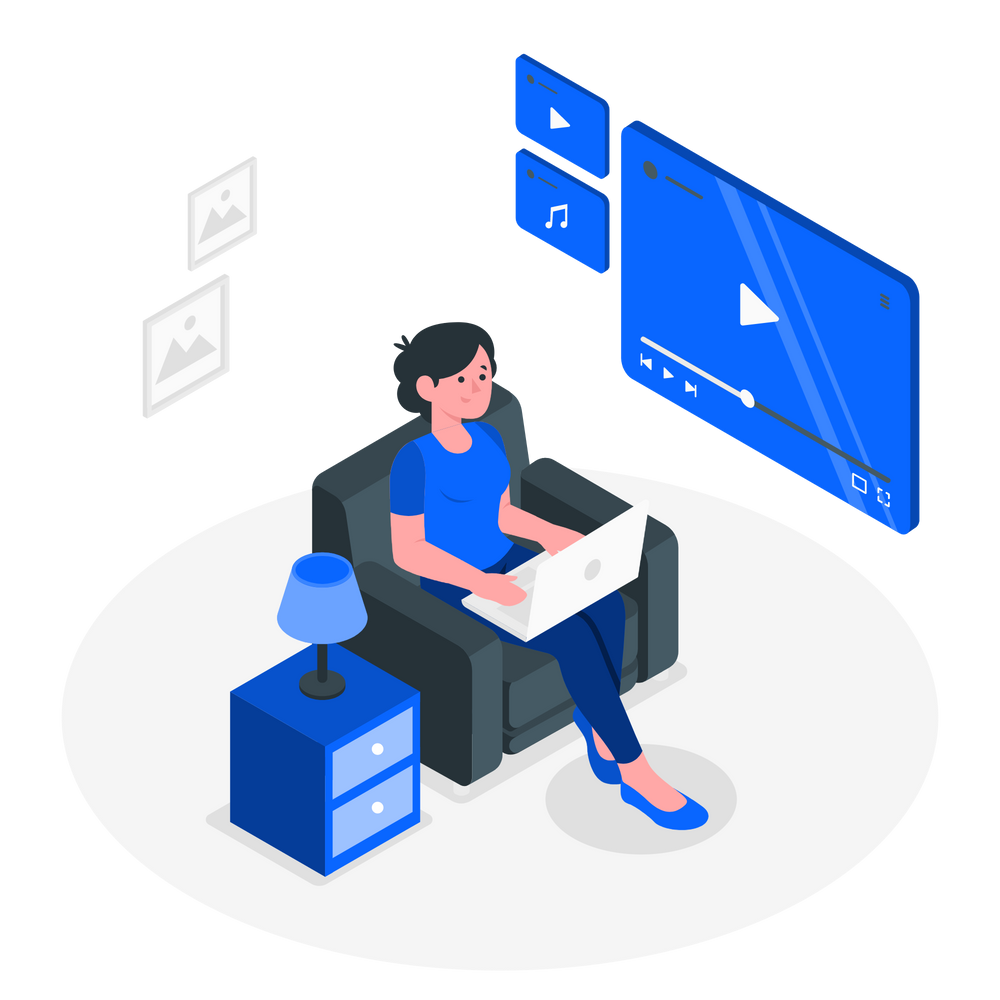
The interview contains both fit questions and case questions. You need to know the basics of case interviews and do some practice in advance – I have written an all-in-one guide right here, so take a look; proper case interview prep takes about 1-2 months at least, so it will only do you good to start even before the tests – heck, even before application.
As for fit questions, be careful to keep your answers highly structured, while displaying the three main attributes of a consultant – leadership, achieving, and problem-solving. Try to apply story-telling techniques – which I discussed in this consulting fit interview guide. The questions are typical for a job interview: “why Bain/why consulting?”, “tell me about that one time you did [insert extraordinary feats]” or “how would you respond in [insert difficult situation]?”.
In all cases, keep your answers short, (but not too short). Your answer should fit nicely into the 2-minute time limit – about 1:50-1:55 is ideal. Prepare your scripts in advance, take note whether you tend to drag on or cut short when under pressure, then adjust accordingly (for example, if you are the “drag on” type, aim for a 1:30-1:40 answer under normal conditions).
Last but not least, dress the part and prepare your setup well. Nothing says “Don’t hire me” like bed hair distorted mic, and lousy lighting. It’s an online, one-way, video interview, but it’s an interview nonetheless, so treat it like any other serious job interview.
How to prepare for Bain Online Test?
Step 1. Verify test format
The first step when preparing for Bain Online Test is to make sure you prepare for the right one!
Do prior research, use your connections, or even contact the target office to find out as many details as possible about their version of the test. Remember, each Bain office is free to decide what, when, where, and how to test their candidates.
Step 2. Practice mental math and numerical reasoning
You cannot escape math. Period.
As I already explained, whatever test format a Bain office uses, there is always going to be math questions. Math is a crucial skill for a consultant, and it is tested in case interviews anyway, so there’s no reason to not start early.
Focus on consulting/business-context math, and mental calculations (because this is a consulting screening test, and calculators are usually prohibited). Most of them are simple calculations/equations, except you need to be careful with large numbers, and you must be quick considering the time pressure.
It’s not difficult to train quick and accurate mental calculations – I believe anyone can do it. Here’s a tried-and-true mental math method I developed and used at McKinsey.
Step 3. Practice fast reading and verbal reasoning
There is a lot of data to process, but only 30-90 seconds for each question, so you must read fast. Really fast. Luckily, I also know 2 techniques to help you with that. I wrote about them in this article, but here is a quick summary.
- The first one, called “Trackers and Pacers” speed up and smooth out your eye movements. The natural, snappy eye movement is a major bottleneck, preventing your brain from fully using its comprehension ability. That’s why you see many experienced readers using pens/pencils to “guide” their eyes in the reading process.
- The second one, called “Perceptual Expansion”, makes full use of your peripheral vision (your eyes’ ability to see to the sides), so instead of reading from the first to the last words of each line, your eyes only need to go through the center ones.
The whole thing is from an experiment called “The PX Project” – and the best thing is that you need only a few hours to start seeing the benefits.
Step 4. Improve business knowledge
This one is most important if you get a Business Case Test, but it’s beneficial for other types too.
It’s also crucial to good performance in case interviews, and if you get into the firm, you can’t work well without background business knowledge.
If you haven’t got a good grasp of business terminology (because not every candidate comes from business background), check out the Starter Guide section in my Case Interview 101 article. Investopedia is a good place to look up for the more advanced stuff, and you can always go to the business section of the nearest bookstore or local library.
The best sources for regular reading include major business magazines such as Forbes or Business Insider, and consulting publication listings such as McKinsey Insights, BCG Reading List, or Bain Publications. And don’t merely read, think too – ask yourself the “why” and “so what” questions for every article. The content there is often up-to-date and quite insightful; however, they require you to get the basics first.
Step 5. Practice case tests / GMAT
If you are required to take case or GMAT-based tests (or both, as in South America), here’s when you start studying for them.
The reason I place them this late in the prep process, is that you need math, reading, some reasoning skills, and some business knowledge to solve effectively.
There are overlaps between the case test and interview – in both cases, you must perform analyses and deliver solutions to business problems using given data. It’s just that the test is more rigid and question-based. That means the “case experience” you get when preparing for case tests is going to help you in the next stage.
For the GMAT-based one, preparation will also increase your chances in other jobs/courses using the same kind of test.
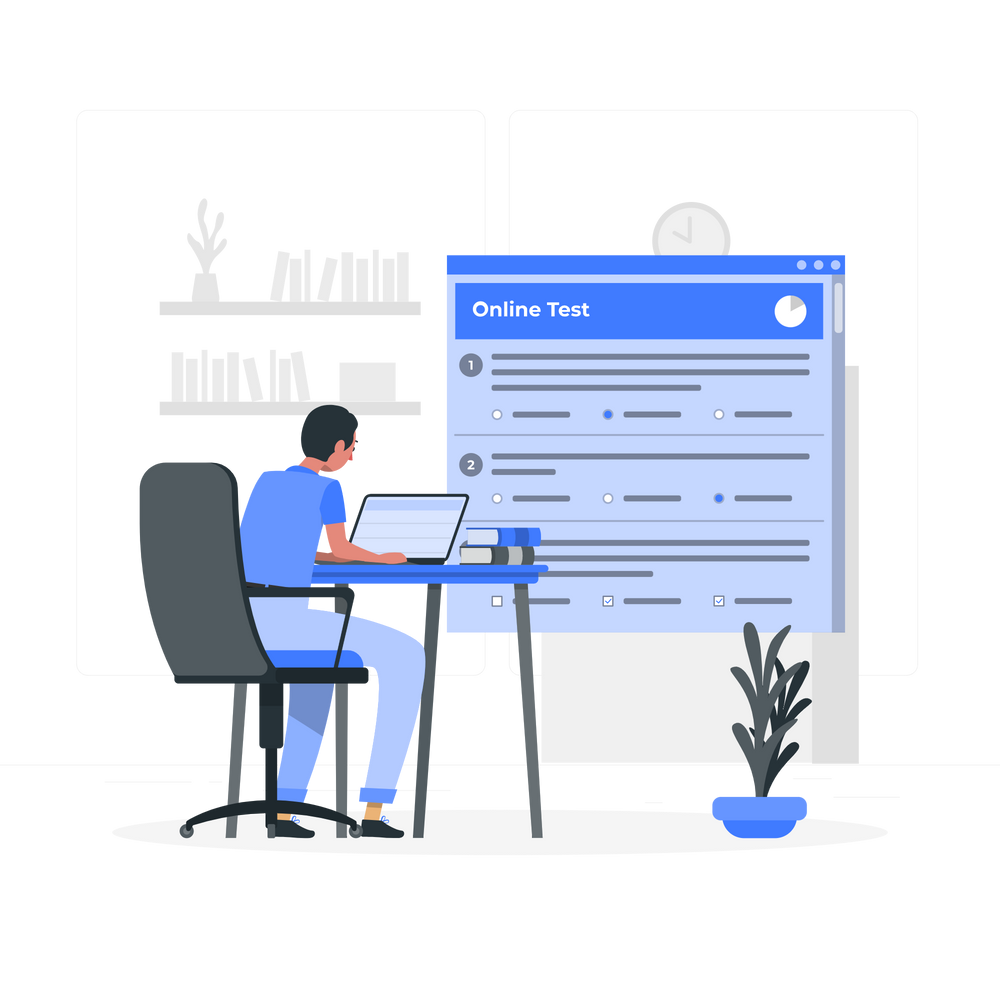
Step 6. Perform full mock tests
Here’s when you put everything together and have your first try. Time your mock test and refrain from using any assistance.
Bain offers no or very few mock tests, so you’ll need to piece together something similar to what you’ll see on the actual test. I’ll put the separate mock tests you can use and a few examples from Bain near the end of this article.
Ideally, your mock tests should be harder, and done in a shorter time than the real ones – hard practice, easy game. This is easier said than done, however – Bain hardly releases anything about their Online Test – so the work-around is to find the hardest mock tests, and self-impose strict time limits.
Step 7. Review, adapt, and overcome
Review your mock test results, develop your personal test strategy, look for your weak points, come back to the previous steps, focus your training efforts accordingly. Rinse and repeat.
With this 8-step self-training process, you can pass the Bain Online Test. It’s not something only a genius can do – it’s a typical job screening test, except more competitive and there’s more of it. As long as you are diligent and careful, you’ll have a good chance.
“What if I have the test next month/next week/tomorrow?”
The prep process I described above is not strictly linear – in real practice, you need to go back and forth between the steps according to your strengths and weaknesses as well as available prep time.
I always advise my readers to “start early” – a few days of reading and mock tests is often not enough to carry you through. However, if push comes to shove, you can always “squeeze” everything in at the same time. Skill training can be omitted if there is way too little time, but always do mock tests (aptitude, case, GMAT) – if anything, it familiarizes you with the format and helps you avoid unpleasant surprises. You can try the free practice test to see the common formats of Aptitude Test.
Tips & Reminders for Bain Online Test
Tip #1. Prepare your equipment
Get yourself the best possible “gears”.
Equip yourself with the fastest, most convenient computer you can get your hands on. Make sure your Internet is fully operable at maximum speed. Even if those things are not readily available, if you wish to be a future consultant, you should be able to borrow someone’s laptop then go to a cafe with good WiFi and quiet working space.
If anything breaks down during the test and you fail, there’s no one to blame, and no “try again” button. You also need backup solutions, in case things don’t go your way.
Also, use mouse instead of touchpads. Many test sites have old, clumsy, or even buggy interfaces, and you need the precision of the mouse in those conditions.
Tip #2. Ready yourself physically and mentally
Eat, sleep and rest well before the test. You are usually allowed to choose the time, so pick when you are most comfortable and alert. Personally, I always take these tests around 9-10 AM, after a full day’s rest, a good night’s sleep and a decent breakfast.
Don’t try to practice or review anything the day before – you don’t want to perform one of the most important tests in your career with a clogged mind.
And don’t forget to perform your “routine bodily functions” right before the test – and I’m not joking. You don’t want Mother Nature knocking on your doors in the middle of a 20-minute inductive reasoning session. I had that experience once – out of pure bad luck – and I can tell you it didn’t feel good at all.
Tip #3. Tell your friends and family
You need 120% concentration for the test so don’t let anybody or anything disturb you.
Screening tests at home are occasions when I get a bit jealous of people who live alone. Tell your family to go on a picnic somewhere; tell your roommate to shut up; tell your girlfriend or boyfriend to not pick on you during the test; tell your friendly neighbor to turn down his volume, and drug his dog with sleeping pills (I didn’t do the last one, but in hindsight I should have).
The point is, you need to minimize every possible distraction. Every single answer counts.
Tip #4. Read the guidelines
(check for calculator permission and guess penalty)
Most firms – Bain included – will give instructions days before the test, and during the test as well.
Take your time to read them carefully, as if your life depends on it (it does – your professional life, that is). Among the instructions, there are two things you should look for, because they affect your test strategy – calculator permission and guess penalty.
Bain offices don’t usually allow calculators in their tests – as with most other consulting firms (because you need mental math skills in consulting). However, guess penalty (i.e.: substracting points for wrong answers) is somewhat more variable, and more ambiguous – I have seen reports of such penalties in the Bain Online Test, so you need to be sure the light is green before blind-guessing your way through problems you can’t solve.
Tip #5. Timebox and prioritize your efforts
Allocate a specific amount of time for each session and each answer. Remember, you only have 30-90 seconds for each – so timing is king. Don’t waste your time on questions you can’t answer – that will leave you scrambling to the finish line at the end of the test, only to collide with the “Rejected” crash barriers.
Bain Online Test samples & materials
The Bain Brazil’s practice tests, as well as materials on consulting math and fast reading are part of our Prospective Candidate Starter Pack – which you can access free of charge through our shop!
Sample tests – Bain Brazil
- Business Case Test 1 – Case Context
- Business Case Test 1 – Questions & Answers
- Business Case Test 2 – Case Context
- Business Case Test 2 – Questions & Answers
- Analytical Test 1 – Questions & Answers
- Analytical Test 2 – Questions & Answers
Math and reading guides
- MCP – Consulting & Mental Math
- MCP – Fast Reading Techniques
Mock aptitude/personality tests and guides
- SHL – Practice Tests
- Cubiks – Practice Tests
- SOVA – Guidelines and Samples
- MConsultingPrep – Practice Tests
Mock GMAT tests and guides
- GMAT Official Starter Pack + Practice Exams 1 & 2
- London Business School – GMAT Practice Tests
- Magoosh – Practice Tests and Guidelines
- Princeton Review – GMAT Practice Tests
If you wish to perform more practice on the Bain Online Test of the SOVA format – you can try out our Aptitude Test Package (recommended for Bain candidates) below – it is a one-size-fits-all package that familiarizes candidates with question types along with tips and tricks to nail every question.
Bain Online Test formats by locations
Bain UK (2018-2024)
- SOVA-based aptitude test with four parts: verbal, numeral, logical reasoning.
- Personality test confirmed, SOVA-based.
- Total time limit: 75 minutes.
Bain Brazil / South America (2016-2024)
- Business case test – 2 cases, 15 questions, 45 minutes.
- Analytical test, 15 questions, 25 minutes.
- Personality test possible, unknown provider.
Bain Singapore / South-East Asia (2018-2024)
- Business case test – 3 cases, 25 questions, 50 minutes.
- Video interview confirmed, HireVue.
/filters:quality(75)//case_thumb/public/1699589977462_aptitude_tests_package_4_x.png)